► Competition for Tesla?
► Porsche and Audi’s electric future
► Mission E and E-tron Quattro explored in-depth
Even in the corridors of Porsche HQ the Mission E concept car is known as ‘Tesla fighter’. Maybe the E stands as much for Elon Musk as it does for Electric. Either way, you’re looking at a seismic shift in impetus for the way premium cars are powered, and the timing could not be more apposite coming from the VW Group at the exact moment its diesel credentials have been savagely invalidated. Has #dieselgate inadvertently accelerated the evolution of the electric car?
It’s not just Porsche – sister brand Audi is going Tesla-chasing too. Its E-tron Quattro concept, which went toe-to-toe with Mission E at the recent Frankfurt motor show, will go into production as the Q6. Both will go on sale in 2018 – soon enough to rattle the teacups at Tesla Towers.
One thing that’s immediately obvious from these pictures is that premium electric cars have to look sensational. The designers have had an absolute field day. Beaming Audi design chief Mark Lichte is as proud as Punch as he lifts the veil off the Q6. ‘This is the signature look you will find on all future electric vehicles by Audi,’ he tells CAR. ‘But this time, it’s the detailing that makes the difference. Check out the bespoke E-tron grille treatment, the five horizontal chrome bars, the staggered brightwork below the headlamps and the full-width taillights which will reappear on other high-end models.’
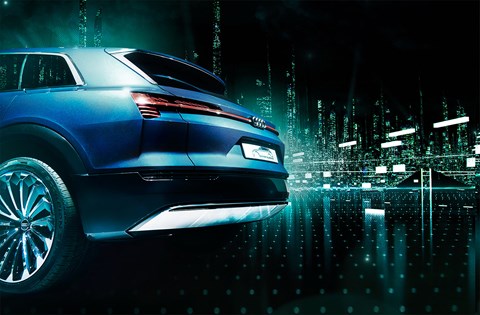
The proportions are indeed much sportier that those of the stately Q7. Which is no surprise since the Q6 has a loose genetic connection to the next Q5. Slightly longer and wider than its sibling, the Q6 is much lower, more coupe-like in profile and yet quite chunky overall. ‘The relatively small frontal area helps us to achieve a drag coefficient of only 0.25. Other contributing factors are cameras instead of door mirrors, three active aerodynamic elements and a controlled airflow through the wheel houses.’ What Lichte forgets to say is that the production version will look like the show car.
Does the E-tron share its zero-emission technology with the Mission E? Yes and No. The lithium-ion batteries, with a combined capacity of 95kWh, will be provided by the same suppliers, LG and Samsung from Korea. But the vehicle concepts differ. Audi has opted for three motors and for an innovative combined charging system which can digest DC (fast) and AC (slower). The monolithic battery pack is integrated in the floorpan for maximum packaging efficiency and the lowest possible centre of gravity. Wireless charging will also be an option. After 50 minutes of charging there should be enough energy on board to cover over 300 miles. In boost mode, the e-motors – one in the front, two in the back – muster, briefly, a combined 503bhp and 590lb ft of torque. Audi claims a 0-62mph time of 4.6 seconds and an electronically limited top speed of 131mph.
Although it is linked to the next Q5 built in Mexico, the home of the Q6 is Brussels. In the former VW factory, Audi plans to install a bespoke assembly line which can eventually handle up to 45,000 vehicles per year. The Q5 matrix, dubbed MLB super evo, will need to be modified to make room for the energy cells and the electric motors. It makes you wonder why the brand’s first battery electric vehicle is an SUV and not a low-drag saloon. I asked that question of Ulrich Hackenberg, who until very recently was board member in charge of r&d. ‘Because of the strong impact this bodystyle has on the market,’ he said. ‘By certifying the vehicle as SUV in North America, we generate a healthy volume base.’ The design is unlikely to change much before production starts in March 2018, but there will be quite a few minor adjustments – such as smaller wheels than the 22-inchers shown here, LED headlamps (not lasers), a motorised rear diffuser and roof spoiler, a less radical cockpit layout (minus the curved OLED display) and a new ergonomic concept derived from the next A8.
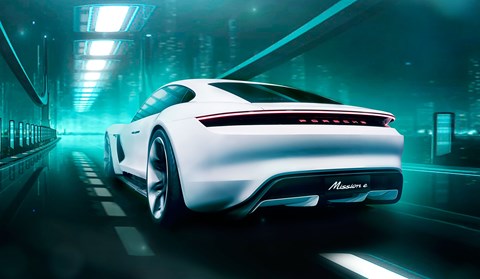
‘We could have developed a bespoke architecture for the Q6, but this would have required a much bigger budget while barely boosting sales because of the higher price,’ Hackenberg tells us. ‘That’s why we settled for a derivative concept which is flexible, relatively affordable and easier to put together.’ For easy repair and maintenance, the batteries – cylindrical pouches bundled in groups, then stuffed in boxes – sit in a readily accessible underfloor drawer. Although the cells are allegedly state-of-the-art, the entire assembly weighs a massive 650kg, making even the lightest Q6 a 2.2 tonne behemoth. A fully equipped top-spec model weighs up to 2.5 tonnes. On the plus side the cargo volume is not compromised by the demands of packaging, remaining at 615 litres, or 75 litres more than Q5.
‘Despite its environment-friendliness, this is also a proper driver’s car,’ claims Hackenberg. ‘It handles like a sporty crossover, it rides very well on height-adjustable air suspension, and thanks to plenty of instant torque the performance is simply amazing.’ Other dynamic assets include big brakes with ample recuperation ability, enhanced stability thanks to rear-wheel steering and aggressive, rear-biased torque vectoring.
Shown at Frankfurt in thin disguise was the top-of-the-line version rated at 435bhp, plus on-demand boost bonus. Although pricing is still tentative, we expect this version to cost about £59,000. Two other versions, a 360bhp model at £51k and a 320bhp entry model at £44k will appear at launch, followed later by an RS hotshoe, which is said to deliver over 680bhp.
If those prices set you reeling, look away now, because Porsche is pitching the four-door Mission E at around £92,000 – right in the face of Tesla’s Model S. ‘We have not yet signed off this project,’ states Porsche chief Matthias Müller – who, since we spoke, has been diverted to the modest challenge of running wounded Volkswagen in the wake of #dieselgate. ‘But when our company presents a show car, it typically reappears at dealerships a few years later.’ Irrespective of its alternative propulsion system, the Mission E – alternatively codenamed Pajun and J1 – is a strikingly beautiful piece of kit designed by Michael Mauer. A crouching 1300mm low (a 911 is taller – at 1303mm), 1999mm wide (911 is 1808mm) and 4850mm long, the most extreme four-door Porsche ever sits on a generous 2890mm wheelbase. This generosity is owed to the bonsai drivetrain which takes up so little space that the plug-in coupe has a second boot in the front, 911-style.
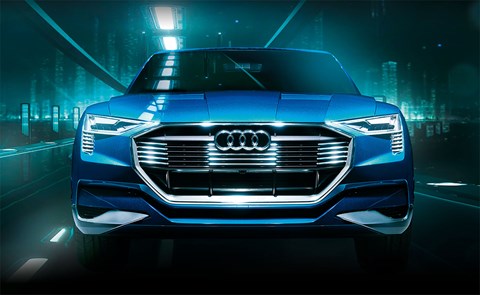
Mission E has a claimed aggregate power output of over 600bhp, split at 33%/66% between the axles. United torque is in excess of 738lb ft, which should be plenty to rush the four-seater from 0-62mph in under 3.5sec. The 0-125mph acceleration time is in the area of 12sec, while top speed is governed at 125mph. Did we hear you say ‘so what?’ After all, the most potent Teslis a good match in Ludicrous Mode (0-62 in 2.8sec, 155 v-max). ‘True,’ admits project leader Stefan Weckbach. ‘But our main emphasis is on repeat performance. The catchword is “reproducibility”. Which is another way of saying that we won’t tolerate the slightest degradation. Our car will accept and master the stopwatch challenge, time after time. Without losing its urge, slowing down, running out of stamina, struggling to meet the range expectations. This promise can be redeemed at random on country roads, the autobahn and even on the race track.’
The key to these ambitious goals is an innovative 800V propulsion system. Hooked up to the mains, the batteries – a joint venture with Audi – take only 15 minutes to recover 80% of their energy. Sounds intriguing, almost revolutionary. So why hasn’t the competition thought of a similar solution? Because right now an 800V charge network exists only on paper. How is Porsche going to jump this hurdle? ‘We are talking to politicians, to other brands, to specialist suppliers like ABB and Siemens,’ says Müller. ‘So far, however, progress has been frustratingly slow. There exists a plan to equip 50 autobahn filling stations with charge points, and yet I am sceptical because the proposed system is basic, slow and inadequate. True, our car could alternatively also be fed through a 400V wall box, but this would at least double the charge time. While cordless inductive charging is another option, setting up our own infrastructure the way Tesla does won’t enter the equation. In my view, we must pull together to make this work.’
The cutaway drawing of the Mission E looks remarkably like a Model S. No surprise – both vehicles use a similar layout featuring an underfloor power pack with a pair of small electric motors at each end driving all four wheels. To warrant a low seating position and a fast dropping roofline, Porsche invented the so-called foot garage, which forms a convenient transverse trench for rear-seat passengers. Despite the compact dimensions, the cabin is airy and spacious. Every occupant has a captain’s chair, and there is no transmission tunnel dividing friends or family. With no propshaft to be stowed away and no engine to intrude, the new dashboard is much slimmer, and the fat centre stack has been replaced by a narrow flybridge.
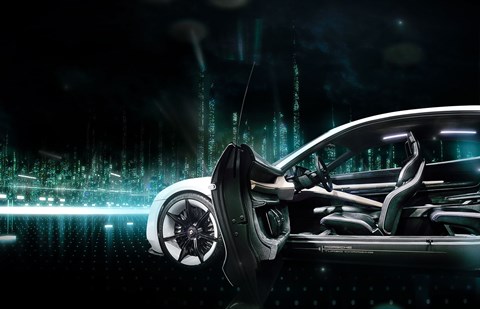
The biggest of the three displays is the curved main instrument panel which shows five animated circular read-outs (Connectivity, Performance, Drive, Energy, Sport Chrono). Those who love to touch, zoom and swipe are invited to use the tablet-size control pad positioned north of the gear selector, again evoking shades of Model S. Across the entire width of the passenger-side facia, a holographic monitor is offering a selection of apps on a video conveyor belt. There is even more fresh digi stuff, such as a surprisingly intuitive multi-functional steering-wheel, the next iteration of gesture control and a new technology named eye contact. This employs a small camera which follows the eyes of the driver, even when he leans back or looks down. By also monitoring posture and seating position, the system automatically adjusts the main dials to match your field of vision. Unlike most other concept cars, Mission E isn’t interested in autonomous driving. ‘In a Porsche the driver wants to be in charge,’ says Müller. ‘That’s why sports cars which do their own thing are not a high priority.’
Every design exercise has at least one eye-catcher; in the Mission E’s case it’s rear suicide doors. They look cute, and they work, but they also add weight, cost and complexity. Without B-posts, extensive reinforcements would be required to meet side-impact standards. Definitely shortlisted for production are the trademark four-beam headlamps, the filigree single-piece tail light and the La Ferrari-inspired doors which cut deep into the sills.
Unlike many rivals, Porsche has rejected the popular asyncronous electric motor in favour of permanent-field machines also known as PSM. Stefan Weckbach explains why. ‘The PSM technology costs twice as much, but it is 20 to 30% lighter, and it heats up later and to a lesser degree. Together with the 800V system, PSM reliably prevents an early loss of power and is therefore vital to ensure the promised range.’ Another key feature is active thermo management. Mission E entertains several cooling circuits to protect batteries, performance electronics and electric motors. When stationary, fans must cool down the most critical items. On the road, the active aero kit automatically channels the airflow through, past, over and under the vehicle. Keeping temperatures at a healthy level is essential for the longevity of the drivetrain and for that critical ‘reproducibility’. Since batteries and software age fast, regular over-the-air updates are a must. What about the hardware, though? ‘We looked at the battery swap principle proposed by Better Place,’ recalls Müller. ‘But in our case it does not make much sense to exchange discharged cells for full ones. Instead, we must find a solution to replace outdated or no longer functioning batteries quickly and economically.’
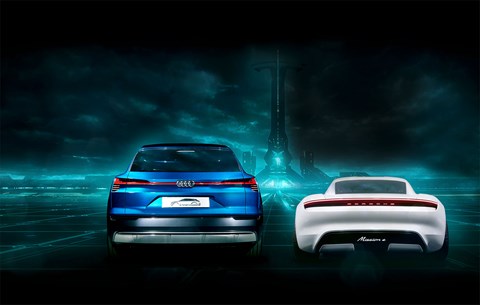
Better coordination and tighter budgets might have helped Audi and Porsche pool their BEV efforts. But with the Not Invented Here banner flying high in Ingolstadt and Weissach, there is very little tangible overlap between the two projects. This may change once the new VW top management beds in. In the wake of the Frankfurt Show, the plan was to build the Porsche in an existing German facility, most likely in Zuffenhausen. While Audi has increased its Q6 volume target from 30,000 to 45,000 units, Porsche has doubled its BEV sales projection from 10,000 to 20,000 cars minimum. A highly significant commitment to an automotive future which – #dieselgate notwithstanding – is changing before our eyes.
Inside Porsche’s Mission E
On the face of it the layout is beautifully simple and adheres to the sacred Porsche principle of sweet balance. There are two permanent magnet synchronous motors, one driving the front axle and one the rear, and as you’d expect of Porsche the bias is heavily towards the rear. In fact, two-thirds of the drivetrain’s combined output of 600bhp is directed to the rear axle.
The electric motors, which also recover braking energy, are similar to those used on the Le Mans-winning 919, though this is their first iteration on a road car.
The drivetrain gives that typical EV character of single-gear instant acceleration (0-62mph in 3.5sec) courtesy of 738lb ft of torque
Mission E is powered by an 800V propulsion system (way too juicy for the current charging network) which would allow an 80% recharge in 15 minutes. The battery packs are located underneath the floor, distributed front and rear, but with a gap just behind the front seats to create a legroom ‘trench’ for back-seat passengers. This allows decent rear headroom from a car with a swooping rear roofline that actually sits 3mm lower than a 911.
The cockpit features all the glass screens you can eat plus sci-fi spec ‘Eye contact’ reactive tech.
1. Main instruments display five readouts: Connectivity, Performance, Drive, Energy, Sport Chrono
2. Touch, zoom and swipe functions on central pad
3. Rear PMSM motor delivers 66% of the drive
4. Battery packs set low for best centre of gravity
5. Front motor drives wheels and recovers brake energy
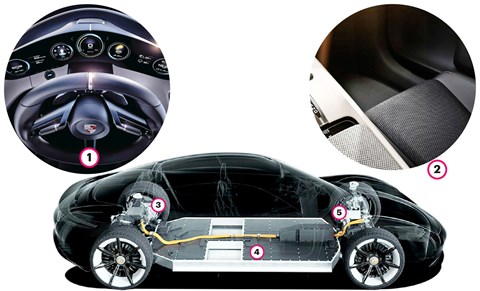
Inside Audi’s Q6 e-tron Quattro
Audi goes one better than Porsche with three electric motors – one at the front, two at the back – together producing 503bhp and 590lb ft of torque. The lithium-ion batteries offer a combined capacity of 95kWh and, like those in the Porsche, are made in Korea by LG and Samsung.
The Q6 has an innovative combined charging system which allows for quick charge (DC) or slow charge (AC). It’ll take around 50 minutes to pack enough energy to offer 300 miles of zero-emissions range. The battery pack is integrated into the floorpan to add structural rigidity, and is packed in an underfloor drawer so it can be easily accessed. The cells may be clean, but they add a frightening 650kg to the kerbweight, making the Q6 a 2.2-tonne porker.
Like the Porsche, the Q6 gives a hot-off-the-line, one-gear launchfest, but 0-62 in 4.6sec isn’t quite as sharp as Mission E. Top speed is limited to 131mph.
Concept features radical OLED instruments, but they won’t make production yet.
1. Central controller shuffles two gears – forward and reverse
2. Front motor drives front wheels and recovers brake energy
3. Battery pack part of the structure – also easy to access
4. Rear motors help achieve rear-bias. Rear wheels also steer
5. Instruments via organic light emitting diodes. Way ahead!
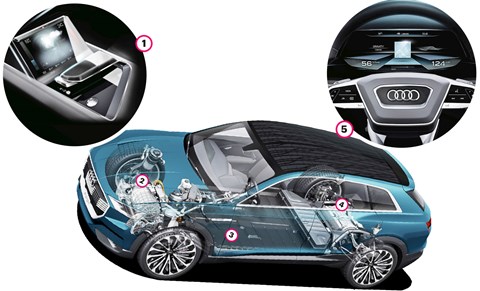
Tesla: we planned to start this EV war
Elon Musk, Tesla’s founder, doesn’t greet competition with dismay. Far from it, he’s an evangelist. ‘Hopefully in 2020, global EVs would be at least a few million a year,’ he tells CAR. ‘I’ve said Tesla wants to be past 500,000 cars annually by then. I hope we succeed. Then I’m sure there’ll be increased activity by the car makers. Tesla’s mission is to accelerate the advent of sustainable transport; hopefully the whole industry goes electric. I think the whole industry will go fully electric in the long run, whether Tesla was here or not. The fundamental of Tesla will be measured by what degree we accelerate that transition. There’ll be
the vehicles we make ourselves, but the vehicles we effectively induce others to make will have a far bigger effect.’